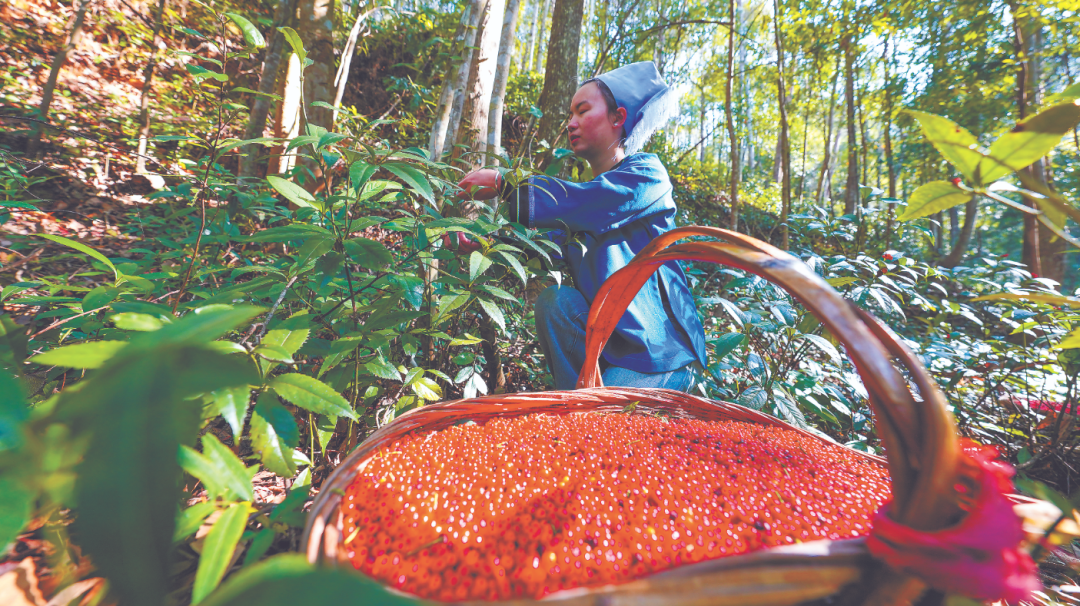Over 9.2 trillion yuan! The total output value of China's forestry and grassland industry has reached a new high
The total output value exceeds 9.2 trillion yuan! The total output value of China's forestry and grassland industry has reached a new high.
On January 22nd, the national forestry and grassland work video conference announced that the total output value of China's forestry and grassland industry exceeded 9.2 trillion yuan. The output of economic forests reached 226 million tons, and forest food became the third largest agricultural product after grain and vegetables. The forest and grass industries such as woody oilseeds, agroforestry, bamboo and rattan flowers, forest and grass seedlings, wood and bamboo processing, and ecotourism are constantly growing.
China's forest product production, trade, and consumption remain the world's top
Where does vigorous development come from?
Relying on policies. Policies and measures such as the "Development Plan for the Forest and Grass Industry (2021-2025)" and the "Three Year Action Plan for Accelerating the Development of the Oil Tea Industry (2023-2025)" have been successively introduced to continuously promote the standardized and healthy development of the forest and grass industry, vigorously cultivate and rationally utilize forest and grass resources, refine the primary industry, strengthen the secondary industry, and expand the tertiary industry, promote deep integration of industries, and expand the supply of high-quality products.
By leading. We have issued and promulgated measures for the establishment and recognition of national forestry industry demonstration parks, the recognition of national forestry key leading enterprises, and the management of national forest economy demonstration bases. We have formulated ten opinions on promoting rural revitalization through forestry and grassland, compiled and printed development guidelines for key areas such as timber industry, bamboo industry, and forest economy development, and led industrial innovation and development.
Relying on the platform. The on-site transaction volume of the first World Forestry Conference was nearly 60 billion yuan, the transaction volume of the 16th China Yiwu International Forest Products Expo was 1.089 billion yuan, and the project signing amount of the 3rd China Xinjiang Characteristic Forest and Fruit Products Expo was 6.45 billion yuan... Various exhibitions were successfully held, comprehensively showcasing the development achievements of China's forestry and grassland industry, and building platforms for product sales, regional cooperation, technological innovation, and chain extension.
In 2023, China's forest product production, trade, and consumption will continue to maintain the world's top position.
226 million tons
National Economic Forest Production

Forest Food (Photo by Feng Lu)
In 2023, China's economic forest production will reach 226 million tons, and forest food will become the third largest agricultural product after grain and vegetables.
Economic forest is the main force of forest food production. Its products include woody grain and oil, dry and fresh fruits, beverage seasoning, health food, forest vegetables, edible essence and spices, and many of them can be directly used as food.
The per capita annual output of economic forest products in China is 128 kg, which strongly supports the upgrading of social consumption structure. The national economic forest area is about 700 million mu, and the current fruit bearing area is about 2/3. There is huge potential for increasing production and income in the future. There are over 90 million people engaged in economic forest planting, accounting for about 18% of the rural population. 726 key counties in the original national poverty alleviation and development work have economic forest planting, accounting for 88% of the total number of poverty-stricken counties. The planting area is over 300 million mu, the output is over 60 million tons, and the output value is over 500 billion yuan, accounting for 48%, 29%, and 33% of the national total, respectively. The population engaged in economic forest planting exceeds 40 million.

Grass Coral Planting Base in Rongjiang County, Qiandongnan Prefecture (Photo by Zhou Guangsheng)
600 million acres
Under forest economic management and utilization of forest land area
The annual output value of the forest economy has remained stable at over 1 trillion yuan.
Underforest economic products are products formed by the development of understory planting, breeding, and collection using forest land.
The national forest economic management and utilization covers an area of 600 million mu, with 950000 various types of management entities. The understory economy provides a rich variety of forest food and traditional Chinese medicine such as forest fungi, forest medicine, forest tea, forest vegetables, forest poultry, forest livestock, and forest bees, with an annual output of 4.9 billion forest poultry and over 50 million forest livestock, making a positive contribution to ensuring food security and building a healthy China.
In 2013, the output value of China's understory economy was 457.5 billion yuan; In 2022, the output value of agroforestry will exceed 1 trillion yuan for the first time.

Keketuohai Ski Resort (Photo by Ethan)
2.1 billion people
Tourist volume of forest and grass ecological tourism
In 2023, China's forest and grass eco-tourism will be reported again: from January to the "National Day" Golden Week, the number of forest and grass eco-tourism tourists will exceed 2.1 billion person times, an increase of 84% year on year, close to the highest level before the COVID-19.
Focusing on the people's growing demand for high-quality and diversified ecological products, ecotourism across the country has shown a vigorous development trend of adding flowers to the "landscape": Guizhou has printed and distributed the Overall Plan of Wuling Mountain National Forest Trail (Guizhou Section), Hunan has opened the demonstration section of the Nanling Mountain National Forest Trail Qitianling, and Beijing, Anhui, Jiangxi, Shandong, Hunan and other places have held distinctive ecotourism product publicity and promotion activities and ecotourism festivals with many highlights to continue to expand the social influence of ecotourism.
From south to north, from spring to winter, from forests and grasslands to wetlands and deserts, ecotourism is becoming a converter of "green mountains and clear waters", "ice and snow" to "gold and silver mountains", adding strong momentum to promote high-quality development.

Karacun Bamboo Weaving Crafts in Longquan Town, Danzhai County (photo provided by Guizhou Forestry Bureau)
400 billion yuan
Annual output value of bamboo industry
There are currently over 10000 bamboo processing enterprises in China, with an annual output value of over 400 billion yuan in the bamboo industry and enormous potential for development.
In 2023, China issued the "Three Year Action Plan to Accelerate the Development of Replacing Plastic with Bamboo" and the "Global Action Plan for Replacing Plastic with Bamboo (2023-2030)". The industrial system of "replacing plastic with bamboo" will be initially established, and the product quality, product types, industry scale, and comprehensive benefits will be further improved. The market share of key products will continue to increase. The National Forestry and Grassland Administration, in conjunction with the Ministry of Science and Technology, has included "bamboo as a substitute for plastic" in the 2023 National Key Research and Development Program's "unveiling and leading" list. The International Bamboo and Vine Center is preparing to establish a national key laboratory for "replacing plastic with bamboo", a national innovation research institute for "replacing plastic with bamboo", and a national innovation alliance for "replacing plastic with bamboo", in order to enhance overall innovation capabilities and comprehensive competitiveness.
Innovation driven policies for the bamboo industry continue to emerge in various regions. In 2023, Fujian Province, Anhui Province, Sichuan Province, and Hunan Province successively issued action plans to promote the high-quality development of the bamboo industry.

Jiangxi Oil Tea Base (Source: China Green Times)
10.18 million acres
New planting and low yield transformation of oil tea
In recent years, the production of tea oil has been increasing year by year, and it has become one of the top ten edible vegetable oils in China.
2023 is the starting year of the "Three Year Action Plan for Accelerating the Development of Camellia Industry (2023-2025)". A total of 10.18 million acres of oil tea have been newly planted and low yield forests have been renovated nationwide, and 721000 acres of oil tea forests damaged by disasters have been replanted and rebuilt by 2022, accounting for 105% of the annual plan tasks of the three-year action plan for the development of the oil tea industry.
In the beginning year, we made solid progress. The National Forestry and Grassland Administration has signed responsibility agreements for the development goals of the oil tea industry with 15 provincial (regional, municipal) governments in oil tea producing areas, consolidating the main responsibility of local governments. Establish an assessment mechanism for oil tea production and conduct assessments on the completion of oil tea production tasks. Organize a national on-site conference on the development of the oil tea industry, hold online and offline oil tea themed training courses, produce video courses and release them to the society. Interpret funding and land policies, promote practical production technologies, and enhance social awareness and recognition of the development of the oil tea industry.
Comprehensive layout and strengthened guidance. The annual production task for oil tea planting, low yield forest transformation, and supplementary planting and production in 2024 is issued to 10.4162 million mu, which will be decomposed and implemented in 797 counties.

Technical personnel from Yichang city conducted sampling in the Zigui walnut production area (photo by Zhang Hailing)
Batch 2477
Carry out soil product monitoring in the production area
Food is of paramount importance to the people, and food safety comes first. In the context of the concept of big food, how can we ensure the safety of the tongue?
In 2023, the National Forestry and Grassland Administration will comprehensively improve the quality monitoring system for forest products. We have carried out monitoring of 42 types of products in four categories across 28 provinces (regions, cities), as well as 2477 batches of soil from 10 forest source medicinal herb production areas. We have issued the "2023-2025 Provincial Edible Forest Product Quality Monitoring Work Plan", guiding localities to carry out quality and safety monitoring of 67000 batches of provincial edible forest products. With the goal of "one overall plan and three full coverage", we have built a comprehensive forest product quality and safety monitoring network. During the Hangzhou Asian Para Games, forestry quality inspection agencies promoted multi-dimensional monitoring of the quality and safety of edible forest products, ensuring zero incidents of edible forest product quality and safety accidents.
Article source: Reprinted from the National Forestry and Grassland Administration